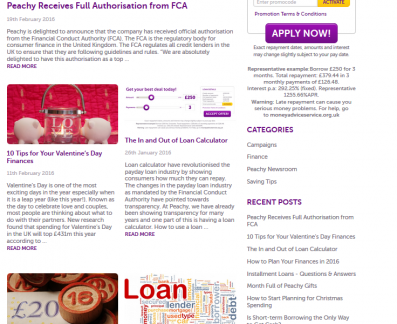Having trouble attracting qualified traffic to your payday loan website? You’re not alone – and that’s the bad news, Payday Loans SEO is tough. You are far from alone. With increasing competition, differentiating your business and attracting visitors to your website has never been more difficult – or more critical.
Competition in the UK: Are You Winning or Losing?
The UK’s payday loan industry has grown substantially in recent years, with the number of borrowers nearing 2 million. At the same time,an increasing number of lenders are scrambling to get a piece of that pie: there are over 240 payday loan firms in the UK, including those with multiple high street branches and those operating online.
The bottom line: firms have to adopt savvy strategies to ensure they will stand out amongst the (fierce) competition.An effective web presence is key to success, and generating qualified traffic is task #1. How?
The Dos and Don’ts of Exploding Your Firm’s Traffic
Do:
- Create original, relevant content. Content is paramount, no matter what field. It is particularly important to online payday lenders. Undeniably, there are a lot of misconceptions and lack of knowledge about the industry; lenders can combat this by providing clear, relevant content that answers their audience’s questions.
For example, Peachy, a leading UK lender, offers content via their blog on topics ranging from smart savings strategies for the New Year to alternatives to short-term borrowing. PayDayLoansNow, another lending site, informs readers on the proper uses for short-term loans, changes in the lending industry, and options for obtaining quick cash.
These posts highlight consumer choice and seek to educate visitors about their options. It is critical that content not “sell” loans but rather inform potential borrowers about the ins and outs of these loans.
- Give them the information they need. What does your target audience want to know about? Use sites like
 BuzzSumo to find trending content and hot topics. You can also use it as an outreach platform to find influencers and to enter into conversations. This can help you share your content to those most interested.
BuzzSumo to find trending content and hot topics. You can also use it as an outreach platform to find influencers and to enter into conversations. This can help you share your content to those most interested. - Offer a variety of content types. Written content can be made exponentially more powerful with relevant images and videos. Research shows that people are 80% more likely to read content if it is accompanied by carefully-selected images, and further, they are more likely to retain the information.
The Online Publishers’ Association found that 80% of viewers recall video ads viewed in the past 30 days, over a quarter look for more information about the product or brand, 22% visit the product site, 15% visit the brand site, and 12% make a purchase.
US lender Castle Payday uses short video content to explain key concepts, such as managing debt and budgeting basics. They run about 1.5 to 2 minutes, which research shows returns the best viewer retention rates. Just as with written content, make sure you have a clear objective, useful tips, and a clear CTA.
- Get mobile-ready.Short-term lenders have to stay on the cutting-edge of technology, and mobile is crucial. Statistics show that most payday borrowers have lower incomes. They need the loans to cover emergencies, car repairs, medicine, etc. before payday. This same demographic tends to rely on mobile devices for their internet access.
Lenders, such as QuickQuid, have fully mobile-optimised sites which enable mobile users to quickly and easily access information they need (including loan amounts, repayment options, and how the process works). They can even apply for loans from their smartphone or tablet.
- Include reviews and ratings. Another area in which QuickQuid leads is with online reviews and ratings. A quick Google search of “UK payday lenders,” puts them at the top of the pack. Their result also has a feature not seen in others: starred reviews.
 Reviews and ratings boost rankings, which is an especially major consideration given the rise of mobile and local searchers. This can be a touchy matter for payday lenders – again, given misconceptions about the industry. But US firm Check ‘n Go discovered their customers were satisfied – and happy to leave reviews. The payday lender began soliciting feedback after each transaction and found they were overwhelmingly positive.
Reviews and ratings boost rankings, which is an especially major consideration given the rise of mobile and local searchers. This can be a touchy matter for payday lenders – again, given misconceptions about the industry. But US firm Check ‘n Go discovered their customers were satisfied – and happy to leave reviews. The payday lender began soliciting feedback after each transaction and found they were overwhelmingly positive.
Check ‘n Go displayed these reviews on landing pages and discovered they performed 12 percent better than control pages. But you must do it right: Check ‘no Go displays all reviews so visitors know that they are authentic. Savvy searchers are on the lookout for fake reviews or those that are too good. The very appearance of dishonesty or impropriety can be devastating to your credibility.
Furthermore, Check ‘n Go uses negative reviews as an opportunity for improvement. Their team could track back and determine issues – and, if possible, publicly address them positively.
- Target the right keywords.Payday lending-related keywords are incredibly competitive. To rank for organic searches, consider natural long-tail keywords. Terms relating to short-term borrowing, budgeting basics, responsible payday loans can help boost traffic, especially if accompanied by high-quality content. You can target keywords by using Google Keyword Planning Tool, using their autosuggestion feature, and analysing competitors’ keywords.
- Enter the social media world.More savvy lenders are making it easy to connect on social platforms. Visitors to the site can simply click a button and see what’s happening on Facebook, Twitter, LinkedIn, Google+, and YouTube.
Short-term lender Sunny, for example, has an active Facebook page that offers content related to their services but –  critically – tips for kicking bad financial habits, money-saving tips, savvy shopping ideas and more. Also included is a section for PilotTrust reviews so consumers can see what peers are saying. Invaluable combination of social and user-generated content.
critically – tips for kicking bad financial habits, money-saving tips, savvy shopping ideas and more. Also included is a section for PilotTrust reviews so consumers can see what peers are saying. Invaluable combination of social and user-generated content.
- Nurture links.Links boost your website’s authority, which boosts your search page visibility, which boosts your traffic.
This is admittedly difficult for payday lenders, which have an unfair disadvantage in that search engines are predisposed to see them as spammy. Build slowly: use links to your own content on social media pages and YouTube. Reach out to financial experts and see if they can contribute guest blogging material and link back to your site. Again, urge customers to leave reviews on sites like Yelp.
- Link Internally.When you offer a rich resource of content for your visitors, employ internal links to help them navigate more easily and quickly. Internal links can increase page views and PageRank while reducing bounce rates.
- Employ SEO techniques.SEO matters, perhaps now more than ever. Sound strategies enable you to achieve higher visibility and grow your traffic. There are a variety of ways to do that, including: optimising page speed, optimising metadata and headlines, optmising images and videos, optimise for local search (e.g. include your location+keyword), using rich snippets properly, and more. Need help? Let us know.
Do Not:
The don’ts are equally – if not more – important than the dos. Payday lenders have to overcome the perception that the industry is inherently “spammy.” Employing the 10 tips above will help. Avoiding the following 5 will as well:
- Purchase or exchange links. Do not. Do not buy, exchange or accept/provide free products or services in exchange for links. You must nurture links naturally or risk a severe penalty from Google and other search engines.
- Scrape, spin or duplicate content.Algorithm updates have targeted “thin” content and attempts to spin content (i.e. rework existing content by changing several words), copy it from other sites, or duplicated it across the web will be penalised. Best: create your own and offer curated content from highly-reputable sources.
- Spam comments. Using forums and other blogs to add to the conversation is a great technique; spamming is not. Whether doing it manually or via software, spamming involves leaving links in the comment section in order to generate a large number of backlinks to your site. This is obvious, easily discovered, and severely detrimental to your ranking and traffic.
- Keyword stuff.This is the technique of “stuffing” keywords into your content and metadata unnaturally. It used to work before search engines became more sophisticated and recognized this as an attempt to “game the system.”
- Bait and switch. Some sites host high-quality content to attract good links, and then switch that material to something that is more commercial or add superfluous links so it is spammy. This bait and switch antagonizes visitors and will eventually end up on Google’s radar.
The Dos and Don’ts In Action: A Peachy Case Study
 How does this look in the real world? Peachy Loans, a UK payday lender, engaged in several “don’ts” in an attempt to increase traffic.
How does this look in the real world? Peachy Loans, a UK payday lender, engaged in several “don’ts” in an attempt to increase traffic.
In 2013, Google released an update to its algorithm, commonly known as the “Payday Loan Update.” It and subsequent updates were aimed at sites and queries that resulted in extremely spammy results. Peachy was hit and saw an 81% decline in organic traffic.
This was devastating: their branded terms were pushed back five and six pages in the search engine results pages, and they depended on search for 30% of their income.
Why was Peachy targeted? They engaged in techniques such as purchasing links, posting “thin content,” keyword stuffing, and featuring duplicate content. They also had broken links and missing metadata.
To address this serious issue, Peachy embarked on an SEO overhaul that featured the following points of attack:
- They did link audits and sought to remove “bad” links from their profile.
- “High-quality” and “relevant” become their guiding keywords. They rewrote their blog content, which was filled with short, keyword-stuffed entries and exact match anchor text. Instead, they featured real information that their audience needed and optimised their titles and metadata.
- User experience. The goal of SEO is to appeal to search engines, sure – but more importantly, sites must appeal to people. Peachy revamped its site, fixed broken links and images, implemented proper tags (e.g. rel=canonical if they had duplicate content), and listed their affiliations/certifications (such as the Consumer Finance Association and Credit Services Association).
The result: Peachy’s organic search rankings climbed. Their penalty was lifted, and they were able to rebound. Today, they rank at or near the top for key terms relating to payday lending/payday loans.
Engaging in sound search engine optimisation and content marketing techniques will help your payday loan website achieve a strong rank and generate traffic. Avoid the “don’ts” at all costs, and put your effort into the many actionable “dos” that can propel your site past the competition.


 (
( (
(
 Like us on Facebook
Like us on Facebook
 Follow us on Twitter
Follow us on Twitter
 Connect on LinkedIn
Connect on LinkedIn